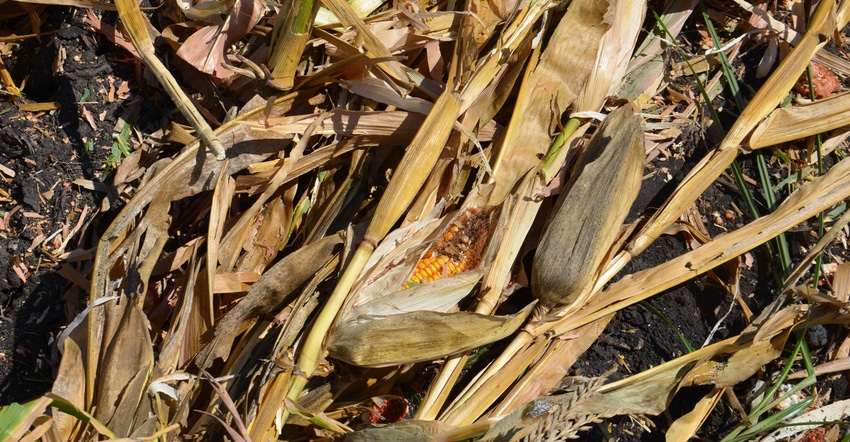September 28, 2021

Some of the worst cornstalk and ear rot fungi live in your soils. Crop rotations help, but some pathogens that cause the most damage can still survive for several years. If you were lucky enough to have ample rains for a good crop, chances are you have some disease organisms “lurking in the bushes,” waiting to attack your corn.
The disease triangle says three things must be present for a disease epidemic: pathogen, susceptible host crop and environment suitable for spread of the pathogen. Foliar fungicides appear to help in the reduction of stalk and ear rots, too. If weather conditions are favorable for the crop, they are also helpful to the disease organisms.
Stalk rots were responsible for some early loss of stalk integrity in 2021. Stalks in many fields failed the pinch or push test at an alarming rate even in mid-September. Dry weather stress may have contributed. Also, in fields where corn ran short of nutrients early, plants may have cannibalized stalks to fill kernels.
Stalk, ear rots
Anthracnose has become one of the dominant stalk rot diseases. This pathogen attacks roots and stalks of plants already weakened by leaf diseases. Spores of this fungus can stay alive in the soil for a long time. This pathogen has been one of the biggest cornstalk killers during the past few years. Anthracnose infects stalks when spores splash from the soil to lower stalk internodes. It makes shiny black spots on stalks that look like shoe polish. Stalks become black inside and can rot and fall over.
Diplodia, gibberella and fusarium stalk rots are caused by fungi that can survive in the soil for many years. A pinkish color inside the stalk pith may indicate fusarium or gibberella stalk rot. Dan Quinn, Purdue University Extension corn specialist, recently reported that in one field, even though tar spot was rampant, looking at the pith indicated fusarium or gibberella might also be present. That is yet unconfirmed.
Diplodia can infect ears, usually starting at the base and spreading to the whole ear. Infected kernels are light in test weight but aren’t known to produce toxins. Gibberella ear rot produces a pink fungus that generally starts at the tips of ears. Fusarium results in white to gray discoloration of groups of kernels or individual kernels scattered across the ear. There may also be a starburst pattern radiating out from the point of silk attachment.
Both gibberella and fusarium can produce mycotoxins. Infected grain should be tested before feeding to livestock. Both diplodia and gibberella can cause significant yield loss if corn isn’t harvested on time.
Aspergillus, another ear rot, is favored by hot, dry weather during grain fill. Symptoms are masses of dusty, olive-green spores on kernels. Aspergillus can produce aflatoxin, a powerful mycotoxin that can result in docks or rejection of corn at elevators.
Scout for ear and stalk rots in corn still in the field by pulling back husks and pushing or pinching stalks. By now, most corn will likely fail pinch or push tests.
Nanda is director of genetics for Seed Genetics Direct, Jeffersonville, Ohio. Email [email protected] or call 317-910-9876. If there’s no answer, please leave a message.
About the Author(s)
You May Also Like






